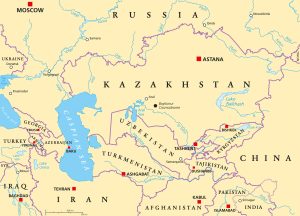According to the European Bank for Reconstruction and Development (EBRD)’s September regional economic outlook, Central Asia is proving more resilient than initially expected to the geopolitical shocks of 2022.
The EBRD revised estimates upward from its May forecasts, with the Central Asia region now expected to grow 4.3 percent in 2022 and 4.8 percent in 2023. This is better than the total area covered by the EBRD, where growth is expected to sit at around 2.3 percent in 2022 and 3 percent in 2023.
According to the EBRD, the upward revisions for Central Asia “reflect a boost to consumption driven by public sector wage hikes, high remittance flows and a sharp increase in shadow trade with Russia, as well as gains in commodity exporters.”
It appears that Russia’s losses in 2022 have been Central Asia’s gains, to a certain extent. The Russian economy, for comparison, is expected to contract 5 percent in 2022 and 3 percent in 2023.
Kazakhstan and Turkmenistan, the EBRD notes, “are enjoying windfall oil and gas revenues as a result of elevated prices and increased export volumes.” In Kazakhstan, the economy is now expected to see 3.0 percent growth in 2022, and 3.5 percent in 2023. Oil exports in the first half of 2022 were up 85 percent year-on-year over 2021, hitting $24.8 billion despite the several interruptions of the Caspian Pipeline Consortium (CPC) operation at Novorossiysk, Russia.
Meanwhile, Kyrgyzstan, Uzbekistan, and Tajikistan “continue to receive substantial remittances from Russia and these show no signs of abating…” The EBRD noted record levels of migrant workers in Russia, with remittances soaring: remittances to Kyrgyzstan increased by 11 percent in the first half of 2022, while remittances to Uzbekistan “were up by 96 per cent year-on-year in the first half of 2022.” Kyrgyzstan, ever volatile, is now expected to see 7.0 percent GDP growth in both 2022 and 2023, after an 8.6 percent contraction in 2020 and growth of around 3.6 percent in 2021. Tajikistan is also expect to see high growth, forecasted at 7 percent in 2022 and 8 percent in 2023. Uzbekistan’s growth is forecasted at 5.5 percent in 2022 and 6.5 in 2023.
Also adding to the Central Asian outlook are efforts by Russian households to park their foreign currency savings in the region. The relocation of both Russian individuals and businesses have further boosted regional economic outlooks. Shadow economies are contributing to economic growth in the region, too. For example, the EBRD noted that “Tajikistan has seen an 85 per cent increase in imports from China” in the first seven months of 2022, “suggesting that the country is serving as a conduit of shadow imports to Russia.”
It’s important to point out that the economic outlook released in late September was prepared before Russian President Vladimir Putin’s September 21 “partial mobilization” announcement triggered a new tsunami of Russians fleeing across the borders into countries like Kazakhstan and catching flights to Kyrgyzstan, Uzbekistan, and Tajikistan as well. This may upset the economic trajectory or, perhaps, serve to reinforce it as even more Russians flee to Central Asia and additional job opportunities open up in Russia — both in the regular labor sector as more Russians are siphoned off to war in Ukraine, but also with the Russian military.
That said, the situation in the region is far from stable or positive. Inflation, in particular, is a serious problem. According to the EBRD, average inflation across the regions it covers reached 16.5 percent in July 2022. Inflation in Kazakhstan in August hit 16.1 percent. It hit 12.3 percent in July in Uzbekistan, and at present is around 14 percent in Kyrgyzstan. Tajikistan reported inflation in August to be around 8.3 percent. The EBRD noted that in general, Central Asian “governments are failing to tighten fiscal policies fast enough as they enjoy record high tax revenues and have political reasons to spend them.”
Outside the scope of the EBRD’s economic outlook but no less important are the social and political ramifications of the new wave of Russians fleeing to Central Asia and efforts by the Russian government to entice Central Asians into the Russian military. The latest wave of Russian migrants into Central Asia is comprised of more desperate young men than relocating entrepreneurs, and the resulting spikes in rental prices in places like Kazakhstan and Kyrgyzstan are concerning for both economic and social reasons. What is good for an economy, may not be good for social cohesion. Many Central Asians will recall flats in Russian cities renting for “Slavs only” and grow frustrated at possibly being priced out of their own neighborhoods. Russians may also bring the paternalistic and frankly racist view of Central Asians held by many in Russia into the Central Asian heartland itself, which could generate conflict.
Regional governments will need to navigate increasingly turbulent waters, balancing the unexpected windfalls presented by the war in Ukraine with the social upheaval and tensions that come with it too. This, of course, is in addition to balancing relations with an increasingly isolated Russia.

































